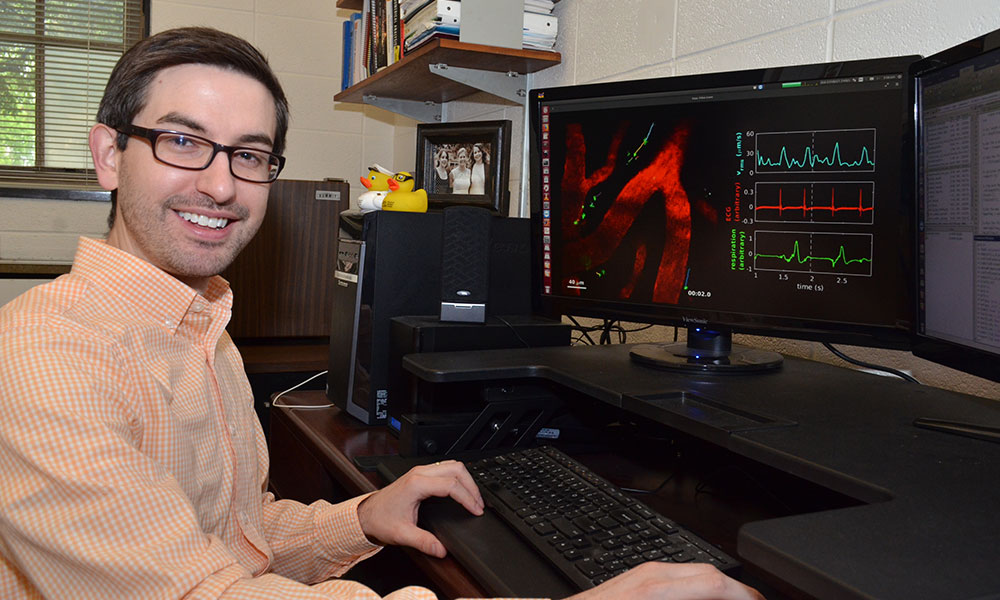Tithof wins major award, defers professorship a year

Jeff Tithof at his computer, displaying measurements of the brain’s glymphatic “waste removal” system.
Jeff Tithof is having a very good spring.
The postdoctoral associate in the Department of Mechanical Engineering just received a prestigious $500,000 Career award from the Burroughs Wellcome Fund, an independent private foundation dedicated to advancing the biomedical sciences.
And he’s been appointed as an assistant professor at the University of Minnesota.
But Tithof is not leaving Rochester just yet. He’s deferred his appointment at Minnesota for one year to continue his research in the lab of Douglas Kelley, associate professor of mechanical engineering at Rochester. The two have been helping Medical Center researchers explore the brain’s glymphatic “waste removal” system, along with Jack Thomas and Jessica Shang, also faculty members in the Department of Mechanical Engineering.
The five-year Burroughs award – one of only 11 Career Awards at the Scientific Interface issued by the foundation this year – is designed to help postdocs transition into an academic appointment. “They prefer you remain a postdoc for one or two years. So even though technically I could have accepted the award, and then gone to Minnesota right away, I thought it would be preferable to Burroughs, and for the sake of getting my own research in order, to defer for a year,” Tithof says. Minnesota was “totally fine with it,” he adds.
In addition, Kelley will be taking a sabbatical this coming academic year in Denmark, working closely with the Copenhagen lab of Maiken Nedergaard, the researcher who first discovered the role played by the glymphatic system. Kelley will go knowing his Rochester lab is in good hands. “Jeff’s going to be the lead mentor here,” Kelley says. “He’s been around the block (with our group). He knows what’s going on, and he can help people out.”
Tithof says he welcomes the “opportunity to essentially help run the group and get some experience doing that.”
Nedergaard, who has appointments at both the University of Rochester and the University of Copenhagen, was the first to describe how cerebrospinal fluid is pumped into brain tissue and flushes away waste.
In collaboration with Nedergaard’s labs, Tithof and Kelley have applied their expertise in fluid dynamics – including a custom automated particle tracking code – to demonstrate that the waste removal system is driven primarily by the pulsations of adjoining arteries. They also showed that changes in the pulsations caused by high blood pressure slow the removal of waste, reducing its efficiency. The findings, reported in Nature Communications, might explain the association between high blood pressure and Alzheimer’s disease, which is characterized by abnormal clumps and tangled bundles of fibers, or plaque, in the brain. (Read more about the study in our Newscenter article.)
Up to now, Tithof and Kelley have primarily been involved analyzing data and creating numerical simulations, based on in vivo experiments conducted with mouse models in the Nedergaard lab.
The sabbatical will give Kelley an opportunity to closely observe those experiments firsthand. “My background is also as an experimentalist, and I get better ideas and understand things more deeply when I am watching the experiments happen,” he says.
“I’ve got some ideas for incorporating our custom particle tracking software into the microscopes, so the researchers could use it real time. I’ve got an idea for a new way to measure flow speeds when we inject dye as opposed to particles, and we’re thinking about actually measuring how the pulsation of the walls changes when plaque starts to accumulate.”
“We have lots of ideas in the air.”
Tithof says he would like to continue researching the glymphatic system and collaborating with Nedergaard and Kelley when he takes up his new post at the University of Minnesota.
“As far as I can tell, there’s no one at Minnesota actively researching the glymphatic system right now,” Tithof says. “It’s a very new area of research. But they also have the most powerful MRI machine in the world that you can put a human in.
“So, I’m hoping that there are some people there who would be interested in collaborating with me and utilizing the MRI.
“That’s the only way to measure the system in humans.”
